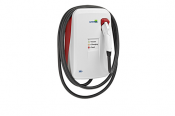625.44 Electric Vehicle Supply Equipment Connections
Change Summary
- The revision clarifies that Level 2 EVSE is permitted to be direct wired or cord- and plug-connected in accordance with 625.17(B)(1) through (4)
- Former 625.13 has been relocated to 625.44 and revised based on approved TIA 11-2 (SC 11-10-4/TIA 1037)
- Subdivision (A) covers cord-connected 125-volt electric vehicle supply equipment and (B) covers all others
| NEC® Text |
|---|
|
All other electric vehicle supply equipment shall be permanently wired and fastened in place to the supporting surface, a wall, a pole, or other structure. The electric vehicle supply equipment shall have no exposed live parts. Copyright© 2013 National Fire Protection Association (See NEC for complete text) |
Expert Analysis
Part III of Article 625 covers electric vehicle supply equipment installations. In the 2011 NEC, there was confusion as to which EVSE was permitted to be cord-and-plug-connected and which units had to be direct wired to the individual branch circuit. The problem was significant enough to trigger a Tentative Interim Amendment TIA 11-2 (SC 11-10-4/TIA 1037) that provided the necessary clarification. As required by the NFPA Regulations Governing Committee Projects, the TIA was introduced as a proposal during the 2014 NEC development process. The result expanded provisions covering requirements for EVSE connections for both direct-wired types and cord-and-plug connected types. It should be noted that the EVSE is required to be listed and as such, should include installation instructions that provide the alternatives for direct connection or cord connection based on the listing of the product. Proposal 12-52 resulted in reorganization of Article 625 and the result is a relocation of 625.13 to 625.44 in Part III of the article. The revision not only improves usability, it addresses concerns expressed by EVSE manufacturers during the 2011 NEC cycle. The revision clarifies that EVSE above 125 volts but not exceeding 250 volts is permitted to be direct wired or cord-and-plug connected to an individual branch circuit where listed and identified.
The Evr-Green® Product Line
Leviton offers a complete solution for residential, commercial and public plug-in electric vehicle (PEV) charging: the Evr-Green® line of electrical vehicle supply equipment (EVSE). Our Evr-Green products are compliant with all industry standards and compatible with all major auto manufacturers’ electric vehicles (SAE J1772 compliant).













